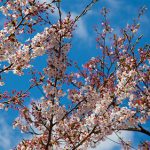Cherry blossom (sakura) is one of the most iconic images of Japan. If you are visiting Japan during the spring, it is well worth trying to time your visit to include viewing the sakura. The blossoms signify the end of winter and the coming of spring. The sakura only appear for a short period (sometimes a week or less) which just adds to their allure. The Japanese see this short burst of beauty as a metaphor for the temporary nature of life itself.
When Is Cherry Blossom Season?
The exact time of the cherry blossom depends on exactly where you are in Japan and the climate in the spring. The first blossoms appear in Okinawa as early as late January and early February. In Hokkaido, trees won’t blossom until May. Most of Honshu (such as Tokyo and Kyoto) sees the blossom come out in early April. These dates can move slightly depending on the weather in the preceding weeks – warm mild weather will cause the blossom to bloom earlier than cold weather. It’s impossible to predict accurately when the trees will blossom until a month or so before when the spring weather patterns are established.
The blooms only last for about 2 weeks between the first buds opening and the last petals falling. The best time to view the blossom is about a week after the first buds start opening as by then the trees should be in full bloom, creating a beautiful blanket of blossom. After a week the blossom start to fall from the trees, which is also very pretty. Rain and wind can strip the petals off the tree quickly so keep an eye out for bad weather forecasts.
Look out for sakura forecasts in the Japanese media as the whole country tracks the wave of blossom moving north across the country. This is usually shown as a weather map with lines showing the predicted dates for each region. You can also check the current predicted dates for the 2014 sakura season across the country online.
What Happens at a Hanami?

Hanami literally means “flower viewing”, but is generally used in relation to cherry blossom viewing. While this can be simply a walk amongst the trees, most people like to take a picnic and spend some time admiring the sakura. It is important to look at the trees from a distance, as well as admire the individual flowers up close.
Popular picnic spots get taken quickly, so get there early if you want a prime spot – in some popular places this means before 8am! You can reserve a spot by putting a picnic blanket down with a sign with your name and planned picnic time. However in the absolute best spots many groups will take it in turns to “guard” their spot for the morning until the picnic later in the day. Some spots are more family orientated while others attract a younger crowd who can drink and party until late at night.
At the most popular spots, you’ll find small markets selling food and drinks, as well as souvenirs and local crafts. You might also encounter musicians and dancers performing traditional Japanese arts. There are also some places where a tea ceremony is performed beneath the sakura; if you get the chance to take part it is the quintessential Japanese cultural experience.
Some people like to wear a yukata or kimono to the hanami, but many people attend in western clothes as well.
Where Are the Best Hanami?

The best sakura spots are often ones that include extra elements to the view, such as a shrine or a castle.
Early blooming trees tend to have no leaves yet, giving a bigger impact than those that bloom later. “Weeping” cherry trees, where the branches dangle towards the ground are deemed to be more beautiful than standard trees.
Look for parks or gardens with large numbers of trees planted close together for a high impact landscapes. Smaller groves of early or late blossoming trees are best if you wish to contemplate the blossom in relative peace.







